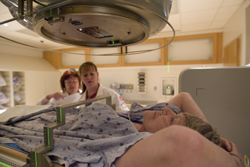Surviving lung cancer
New technique boasts high cure rates, offers hope in place of surgery
| Countless people have heard the phrase, “You have lung cancer,” but only 50 can say they’ve completed a new treatment at Temple University that doubles their chances of surviving the deadly disease — and without the conventional radiation regimen or surgery. Doctors in the Radiation Oncology Department say the technique, stereotactic body radiotherapy, or SBRT, not only improves a person’s odds of surviving early stage lung cancer, but may reduce the need for future surgeries.
“This is a big trend in radiation oncology for early stage lung cancer patients who either can’t undergo surgery or refuse it,” says Curtis Miyamoto, M.D., chair and professor of the Department of Radiation Oncology at the School of Medicine. “With the success of this technique, we’re now questioning whether we’ll even be doing surgeries on these patients in the future.” |
 Photo by Ryan S. Brandenberg/Temple University
Conquering cancer: A body immobilizer keeps Carol Whelan still as she undergoes stereotactic body radiotherapy, or SBRT. She knows the technique may improve her chances of surviving lung cancer. Here, she undergoes her first treatment of targeted, high-dosage radiation, which will last from 30 to 45 minutes.
|
|
|
|
|
Treating lung cancer with conventional radiation is a burdensome process. Patients receive radiation therapy, which kills the cancerous cells and shrinks tumors, five days a week for six to seven weeks. The travel alone can be a hardship for patients not living in the city. In contrast, SBRT requires only three to eight treatments, not 35. Once malignancy is confirmed through a PET CT scan or biopsy, treatments can begin. Patients are placed in an immobilizing body frame to reduce movement so that doctors can focus radiation on the tumor while reducing exposure of healthy tissue. Although both traditional treatments and SBRT methods involve radiation, SBRT administers large, highly precise doses instead of multiple smaller doses. But perhaps the most important advantage of SBRT is its effectiveness: Patients who refuse or cannot receive conventional treatments for their lung cancer face a median survival range of nine months. For those who undergo SBRT, the median survival range is more than 32 months. And depending on the size and seriousness of the tumor, the two-year disease free survival, or cure rate through SBRT increases to approximately 81 percent and can reach up to 98 percent, according to findings in the International Journal of Radiation OncologyBiologyPhysics. The cure rate with conventional radiation is closer to 35 percent; SBRT doubles the odds of surviving early stage lung cancer and can actually cure at least half of the patients. “Such high survival rates are equivalent to other techniques, like invasive surgery, but you don’t have to go under the knife,” says Miyamoto. “I think the big thing the patient notices is it’s all done very quickly and the results are impressive.” That’s welcome news to Americans considering lung cancer is the second most diagnosed cancer in men and women (after prostate and breast, respectively), but it is the number one cause of death from cancer every year in both men and women, according to statistics from LungCancer.org. Miyamoto will present information on SBRT this June before the Asociacion Latinoamericana de Terapia Radiante Oncologica, or ALATRO, which represents Spanish- and Portuguese-speaking radiation oncologists who treat approximately 500 million people outside the United States. |